非谓语动词作状语教学提纲
非谓语动词作状语在写作中的应用(教案)
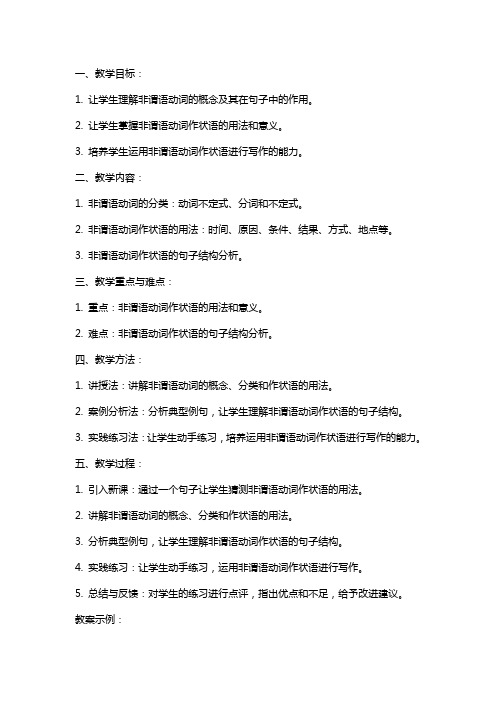
1. 让学生理解非谓语动词的概念及其在句子中的作用。
2. 让学生掌握非谓语动词作状语的用法和意义。
3. 培养学生运用非谓语动词作状语进行写作的能力。
二、教学内容:1. 非谓语动词的分类:动词不定式、分词和不定式。
2. 非谓语动词作状语的用法:时间、原因、条件、结果、方式、地点等。
3. 非谓语动词作状语的句子结构分析。
三、教学重点与难点:1. 重点:非谓语动词作状语的用法和意义。
2. 难点:非谓语动词作状语的句子结构分析。
四、教学方法:1. 讲授法:讲解非谓语动词的概念、分类和作状语的用法。
2. 案例分析法:分析典型例句,让学生理解非谓语动词作状语的句子结构。
3. 实践练习法:让学生动手练习,培养运用非谓语动词作状语进行写作的能力。
五、教学过程:1. 引入新课:通过一个句子让学生猜测非谓语动词作状语的用法。
2. 讲解非谓语动词的概念、分类和作状语的用法。
3. 分析典型例句,让学生理解非谓语动词作状语的句子结构。
4. 实践练习:让学生动手练习,运用非谓语动词作状语进行写作。
5. 总结与反馈:对学生的练习进行点评,指出优点和不足,给予改进建议。
教案示例:a. 让学生理解非谓语动词的概念及其在句子中的作用。
b. 让学生掌握非谓语动词作状语的用法和意义。
c. 培养学生运用非谓语动词作状语进行写作的能力。
2. 教学内容:a. 非谓语动词的分类:动词不定式、分词和不定式。
b. 非谓语动词作状语的用法:时间、原因、条件、结果、方式、地点等。
c. 非谓语动词作状语的句子结构分析。
3. 教学重点与难点:a. 重点:非谓语动词作状语的用法和意义。
b. 难点:非谓语动词作状语的句子结构分析。
4. 教学方法:a. 讲授法:讲解非谓语动词的概念、分类和作状语的用法。
b. 案例分析法:分析典型例句,让学生理解非谓语动词作状语的句子结构。
c. 实践练习法:让学生动手练习,培养运用非谓语动词作状语进行写作的能力。
5. 教学过程:a. 引入新课:通过一个句子让学生猜测非谓语动词作状语的用法。
非谓语动词作状语教案
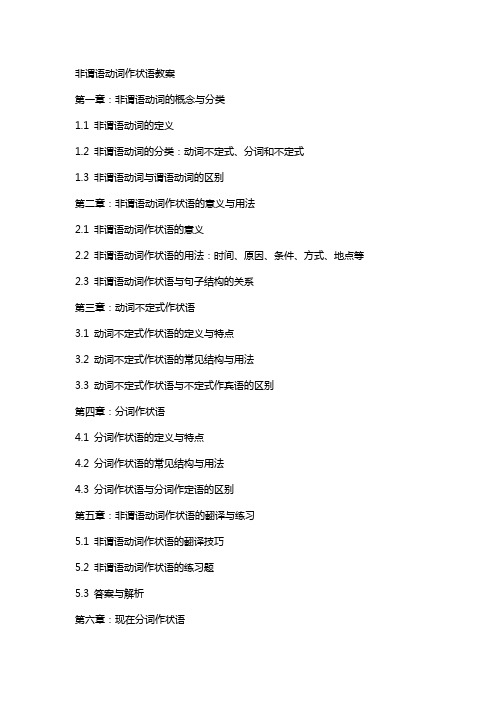
非谓语动词作状语教案第一章:非谓语动词的概念与分类1.1 非谓语动词的定义1.2 非谓语动词的分类:动词不定式、分词和不定式1.3 非谓语动词与谓语动词的区别第二章:非谓语动词作状语的意义与用法2.1 非谓语动词作状语的意义2.2 非谓语动词作状语的用法:时间、原因、条件、方式、地点等2.3 非谓语动词作状语与句子结构的关系第三章:动词不定式作状语3.1 动词不定式作状语的定义与特点3.2 动词不定式作状语的常见结构与用法3.3 动词不定式作状语与不定式作宾语的区别第四章:分词作状语4.1 分词作状语的定义与特点4.2 分词作状语的常见结构与用法4.3 分词作状语与分词作定语的区别第五章:非谓语动词作状语的翻译与练习5.1 非谓语动词作状语的翻译技巧5.2 非谓语动词作状语的练习题5.3 答案与解析第六章:现在分词作状语6.1 现在分词作状语的定义与特点6.2 现在分词作状语的常见结构与用法6.3 现在分词作状语与过去分词作状语的区别第七章:过去分词作状语7.1 过去分词作状语的定义与特点7.2 过去分词作状语的常见结构与用法7.3 过去分词作状语与现在分词作状语的区别第八章:非谓语动词作状语的句子分析8.1 非谓语动词作状语的句子结构分析8.2 非谓语动词作状语的句子类型分析8.3 非谓语动词作状语的句子实例分析第九章:非谓语动词作状语的语法辨析9.1 非谓语动词作状语与作宾语的语法辨析9.2 非谓语动词作状语与作定语的语法辨析9.3 非谓语动词作状语与作补语的语法辨析第十章:非谓语动词作状语的综合练习与解答10.1 非谓语动词作状语的综合练习题10.2 答案与解析10.3 非谓语动词作状语的实践与应用重点和难点解析一、非谓语动词的分类:动词不定式、分词和不定式补充说明:动词不定式作状语时,常常表示目的、结果、原因等;分词作状语时,可以表示时间、原因、条件等;不定式作状语时,通常表示方式、地点等。
非谓语动词做状语(讲课用)

3. When the library is completed, it will be open to the public next year. _________________ When completed, the library will be open to the public next year. 4.When she was asked why she did it,
she began to cry. Asked why she did it, they kept running. __________________
5.The children came into the classroom,
and they laughed and talked.(并列句)
Even if what we need is just a glass of water, she will also keep it in mind. When ________(notice) noticing her grey hairs and the wrinkles around her eyes, I realize I have grown up while she is no longer young. It’s time that I should do something for her, even only _______(give) back some messages making giving or ________(make)a cup of tea for her. It can make her feel that she seems to be the happiest woman in the world. Do you know who she is? She is our Mom
【高中英语】《语法—非谓语动词作状语》优质课教案
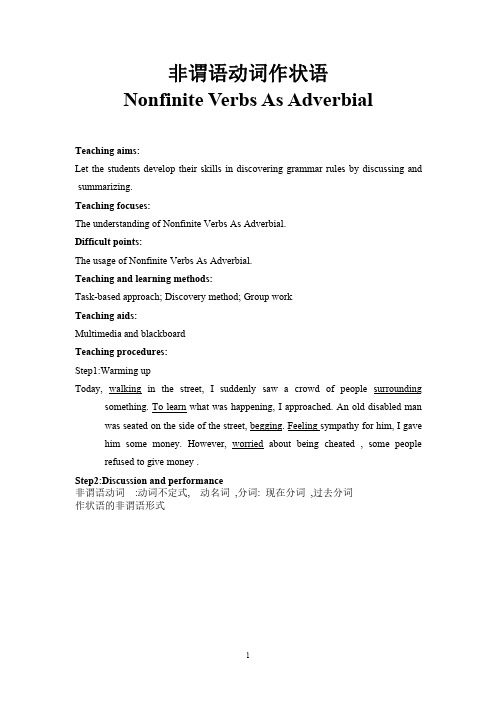
非谓语动词作状语Nonfinite Verbs As AdverbialTeaching aims:Let the students develop their skills in discovering grammar rules by discussing and summarizing.Teaching focuses:The understanding of Nonfinite Verbs As Adverbial.Difficult points:The usage of Nonfinite Verbs As Adverbial.Teaching and learning methods:Task-based approach;Discovery method;Group workTeaching aids:Multimedia and blackboardTeaching procedures:Step1:Warming upToday,walking in the street,I suddenly saw a crowd of people surrounding something.To learn what was happening,I approached.An old disabled man was seated on the side of the street,begging.Feeling sympathy for him,I gave him some money.However,worried about being cheated,some people refused to give money.Step2:Discussion and performance非谓语动词:动词不定式,动名词,分词:现在分词,过去分词作状语的非谓语形式To have doneTo bedone To do 不定式done过去分词Having done Beingdone doing 现在分词完成式被动式一般式 形式种类高考衔接1.____into English,the sentence was found to have an entirely different word order.(2019课标)A.Translating B.Translated C.To translate D.Having translated2._____around the fire,the tourists danced with the local people.(2011辽宁)A.Gather B.To gather C.Gathering D.Gathered3.There ____no classes yesterday,we paid a visit to The Great Wall.(2009全国)A.Was B .were C.being D.had been4._____the website of the Fire Department in your city ,and you will learn a lot about firefighting .(2018湖南)A To searchB .SearchingC .SearchD .Having searched5._____in the queue for half an hour,Tom suddenly realized that he had left his wallet at home.(2019全国)A.To waitB.Have waitedC.Having waitedD.To have waitedStep3:Checking and practiceCheck the facts with the students and do some practice.一.分析句子结构一个句子当中,已经存在一个主句(谓语动词),又没有连词的情况下,应考虑非谓语.二.分析逻辑主语确定要选非谓语动词之后,第二步要分析其逻辑主语,其逻辑上的动作执行者就叫做逻辑主语。
非谓语动词作状语在写作中的应用(教案)
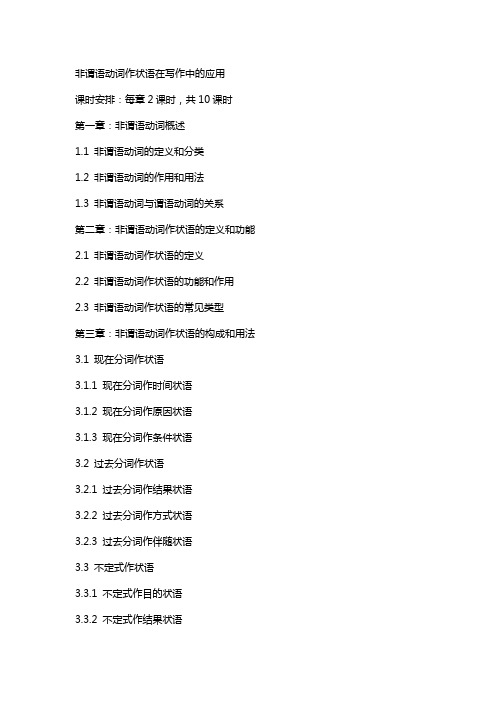
非谓语动词作状语在写作中的应用课时安排:每章2课时,共10课时第一章:非谓语动词概述1.1 非谓语动词的定义和分类1.2 非谓语动词的作用和用法1.3 非谓语动词与谓语动词的关系第二章:非谓语动词作状语的定义和功能2.1 非谓语动词作状语的定义2.2 非谓语动词作状语的功能和作用2.3 非谓语动词作状语的常见类型第三章:非谓语动词作状语的构成和用法3.1 现在分词作状语3.1.1 现在分词作时间状语3.1.2 现在分词作原因状语3.1.3 现在分词作条件状语3.2 过去分词作状语3.2.1 过去分词作结果状语3.2.2 过去分词作方式状语3.2.3 过去分词作伴随状语3.3 不定式作状语3.3.1 不定式作目的状语3.3.2 不定式作结果状语3.3.3 不定式作原因状语第四章:非谓语动词作状语的注意事项4.1 非谓语动词作状语的逻辑主语4.2 非谓语动词作状语的主谓关系4.3 非谓语动词作状语的时态和语态第五章:非谓语动词作状语在写作中的应用实例5.1 现在分词作状语的应用实例5.2 过去分词作状语的应用实例5.3 不定式作状语的应用实例教学评估:通过课堂讲解、练习和写作实践,评估学生对非谓语动词作状语的理解和应用能力。
教学资源:教案、PPT、练习题、写作材料。
教学方法:采用讲解、练习和写作实践相结合的方式,帮助学生理解和掌握非谓语动词作状语的用法。
通过实例分析和练习,培养学生在写作中灵活运用非谓语动词作状语的能力。
第六章:现在分词作状语的扩展应用6.1 现在分词作让步状语6.2 现在分词作转折状语6.3 现在分词作对比状语第七章:过去分词作状语的扩展应用7.1 过去分词作假设状语7.2 过去分词作强调状语7.3 过去分词作比较状语第八章:不定式作状语的扩展应用8.1 不定式作可能状语8.2 不定式作选择状语8.3 不定式作程度状语第九章:非谓语动词作状语的复合应用9.1 非谓语动词作状语的复合结构9.2 现在分词与过去分词的复合应用9.3 不定式与现在分词、过去分词的复合应用第十章:非谓语动词作状语在写作中的高级应用10.1 非谓语动词作状语的连用10.2 非谓语动词作状语的独立主格结构10.3 非谓语动词作状语的倒装句式教学评估:通过课堂讲解、练习和写作实践,评估学生对非谓语动词作状语的理解和应用能力。
非谓语动词作状语教案
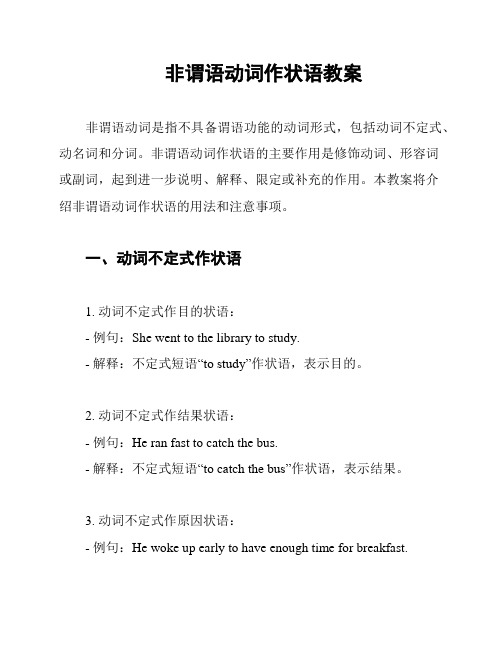
非谓语动词作状语教案非谓语动词是指不具备谓语功能的动词形式,包括动词不定式、动名词和分词。
非谓语动词作状语的主要作用是修饰动词、形容词或副词,起到进一步说明、解释、限定或补充的作用。
本教案将介绍非谓语动词作状语的用法和注意事项。
一、动词不定式作状语1. 动词不定式作目的状语:- 例句:She went to the library to study.- 解释:不定式短语“to study”作状语,表示目的。
2. 动词不定式作结果状语:- 例句:He ran fast to catch the bus.- 解释:不定式短语“to catch the bus”作状语,表示结果。
3. 动词不定式作原因状语:- 例句:He woke up early to have enough time for breakfast.- 解释:不定式短语“to have enough time for breakfast”作状语,表示原因。
二、动名词作状语1. 动名词作时间状语:- 例句:I enjoy swimming in the morning.- 解释:动名词短语“swimming in the morning”作状语,表示时间。
2. 动名词作原因状语:- 例句:She failed the exam due to not studying enough.- 解释:动名词短语“not studying enough”作状语,表示原因。
三、分词作状语1. 现在分词作时间状语:- 例句:Walking along the street, she noticed a bookstore.- 解释:现在分词短语“Walking along the street”作状语,表示时间。
2. 过去分词作原因状语:- 例句:Feeling tired, he decided to take a break.- 解释:过去分词短语“Feeling tired”作状语,表示原因。
非谓语动词作状语教案
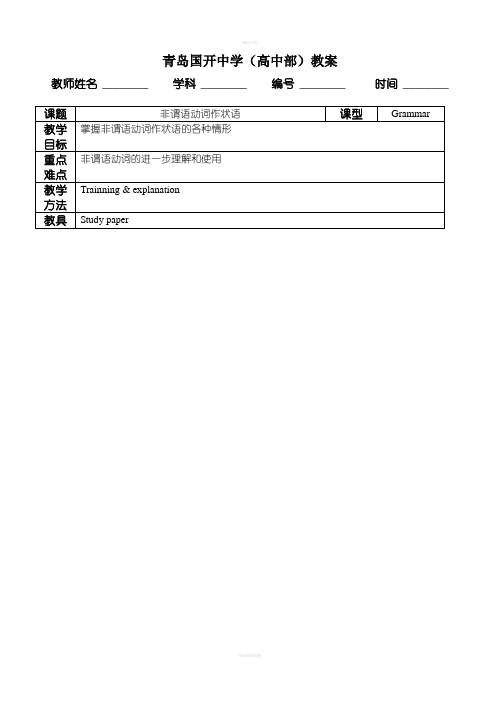
C. Exciting; happilyD. Excited; happy
教学
过程
设计
4. ____ deep down in the earth, the dead forests rotted away and became coal.
A.C. although born D. being born
7. Anna was reading a piece of science fiction, ____ completely to the outside world.
A. being lost B. having lost C. losing D. lost
②Though _____ (tell) of the danger, he still risked his life to save the boy.
分词作状语时, 需注意事项:
A.分词短语作状语时,它的逻辑主语通常应是________ :
____ (see) from the hill, the city is beautiful.
②The teacher stood there, ______ (surround) by a lot of students.
D.作条件状语:
Eg.)①______ (give) another chance, I would have done the job far better.
=______________ , I would have done the job far better.
8. Everything ____, it wasn’t a bad holiday.
高中英语复习教案《非谓语动词作状语》

教学内容
教学活动
设计意图
Step 1
Lead-in
(5 mins)
1.。
2.非谓语动词的三种基本形式;
3.非谓语的句法功能
1.视频导入
教师播放视频,学生观看视频并积极思考视频中的内容跟英语语法中的哪个知识点相关。
2.提问复习
(1)非谓语动词的基本形式有哪三种?
2.能在解题时选择正确的非谓语的形式。
素质目标
1.养成认真细致的解题习惯;
2.形成自觉总结知识点的思维。
教学重点
1.非谓语动词作状语的用法;
2.掌握非谓语动词作状语相关题目的解题技巧。
教学难点
1.逻辑主语和非谓语动词的主被动关系确定;
2.非谓语动词形式的正确选择。
二、教学实施Teaching Process
学情分析
通过前两个学时的复习,学生已掌握非谓语动词的定义、用法及三种基本形式,但对于非谓语作状语的了解还有所欠缺,在解题的时候不知道该选择哪种形式。
教学目标
知识目标
1.掌握非谓语动词的使用条件;
2.掌握非谓语动词作状语的用法;
3.掌握非谓语动词作状语相关题目的解题技巧。
能力目标
1.能在句子中熟练使用非谓语动词作状语
Consolidation
(10 mins)
高考真题习题练习
教师讲解解题思路,要求学生先完成练习,再引导学生讲解解题思路。
真题练习对本课知识点进行检测,让复习更有针对性。
Step 5
Homework
(5 mins)
非谓语动词知识点相关习题
布置课后巩固作业
进一步培养学生认真、细致完成作业的习惯
三、教学反思
(2)非谓语可以在句子中充当什么成分?
非谓语动词作状语
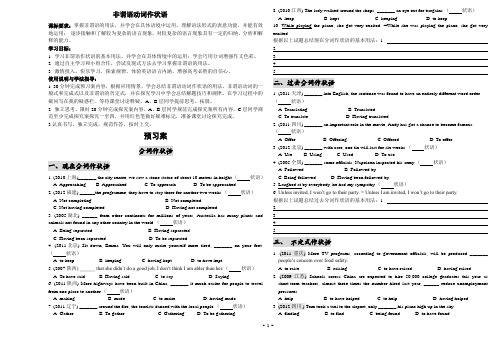
非谓语动词作状语课标要求:掌握非谓语的用法,并学会在具体语境中运用。
理解语法形式的表意功能,并能有效地运用;逐步接触和了解较为复杂的语言现象,对较复杂的语言现象具有一定的归纳、分析和解释的能力。
学习目标:1. 学习非谓语作状语的基本用法,并学会在具体情境中的运用;学会巧用分词增强作文色彩。
2. 通过自主学习和小组合作,尝试发现式方法去学习掌握非谓语的用法。
3. 激情投入,快乐学习,探索规律,体验英语语言内涵,增强高考必胜的自信心。
使用说明与学法指导:1. 30分钟完成预习案内容,根据应用情景,学会总结非谓语动词作状语的用法,非谓语动词的一般式和完成式以及非谓语的否定式,并在探究学习中学会总结解题技巧和规律。
在学习过程中的疑问写在我的疑惑栏,等待课堂讨论释疑。
A、B层同学提前思考、拓展。
2. 独立思考,限时20分钟完成探究案内容。
A、B层同学规范完成探究案所有内容,C层同学规范至少完成探究案探究一至四,并用红色笔做好疑难标记,准备课堂讨论探究完成。
3.认真书写,独立完成,规范作答,按时上交。
预习案分词作状语一、现在分词作状语1. (2010上海)_______ the city centre, we saw a stone statue of about 10 metres in height.(状语)A. ApproachingB. ApproachedC. To approachD. To be approached2. (2012福建) ______the programme, they have to stay there for another two weeks.(状语)A. Not completingB. Not completedC. Not having completedD. Having not completed3. (2005湖北) ______ from other continents for millions of years, Australia has many plants and animals not found in any other country in the world.(状语)A. Being separatedB. Having separatedC. Having been separatedD. To be separated4. (2011北京) Sit down, Emma. You will only make yourself more tired, _______ on your feet.(状语)A. to keepB. keepingC. having keptD. to have kept5. (2007陕西) ______ that she didn’t do a good job, I don’t think I am abler than her.(状语)A. To have saidB. Having saidC. to sayD. Saying6. (2011陕西) More highways have been built in China, _______ it much easier for people to travel from one place to another.(状语)A. makingB. madeC. to makeD. having made 7. (2011辽宁) _______ around the fire, the tourists danced with the local people.(状语)A. GatherB. To gatherC. GatheringD. To be gathering8. (2010江西) The lady walked around the shops, _______ an eye out for bargains.(状语)A. keepB. keptC. keepingD. to keep10. While playing the piano, she got very excited. =While she was playing the piano, she got very excited.根据以上试题总结现在分词作状语的基本用法:1.2.3.4.5二、过去分词作状语1. (2011天津) _______ into English, the sentence was found to have an entirely different word order.(状语)A. TranslatingB. TranslatedC. To translateD. Having translated2. (2011四川) _______ an important role in the movie, Andy has got a chance to become famous.(状语)A. OfferB. OfferingC. OfferedD. To offer3. (2012北京) _______ with care, one tin will last for six weeks.(状语)A. UseB. UsingC. UsedD. To use4. (2005全国) _______ some officials, Napoleon inspected his army.(状语)A. FollowedB. Followed byC. Being followedD. Having been followed by5. Laughed at by everybody, he had my sympathy.(状语)6. Unless invited, I won’t go to their party. = Unless I am invited, I won’t go to their party.根据以上试题总结过去分词作状语的基本用法:1.2.3.4.5.三、不定式作状语1. (2011重庆) More TV programs, according to government officials, will be produced _______ people’s concern over food safety.A. to raiseB. raisingC. to have raisedD. having raised2. (2009江苏) Schools across China are expected to hire 50,000 college graduates this year as short-term teachers, almost three times the number hired last year, ______ reduce unemploymentpressures.A. helpB. to have helpedC. to helpD. having helped3. (2012四川,) Tom took a taxi to the airport, only _______ his plane high up in the sky.A. findingB. to findC. being foundD. to have found4. (2012山东) George returned after the war, only _______ that his wife had left him.A. to be toldB. tellingC. being toldD. told5. (2010辽宁) We were astonished _______ the temple still in its original condition.A. findingB. to findC. findD. to be find6. (2012全国II) The old man sat in front of the television every evening, happy _______ anything that happened to be on.A. to watchB. watchingC. watchedD. to have watched根据以上试题总结不定式作状语的基本用法:1.2.3.4.5.四、独立结构作状语(1)名词+分词作状语1. (2012全国I) The party will be held in the garden, weather _______.A. permittingB. to permitC. permittedD. permit2. (2011浙江) Bats are surprisingly long-lived creatures, some _______ a life span of around 20 years.A. havingB. hadC. haveD. to have3. (2005湖南) I send you 100 dollars today, the rest _______ in a year.A. followB. followedC. to followD. being followed4. (2007山东) The country has already sent up three unmanned spacecraft, the most recent ______ at the end of last March.A. has been launchedB. having been launchedC. being launchedD. to be launched比较下面两个句子:(1)The country has already sent up three unmanned spacecraft, the most recent of which ______ at the end of last March.A. has been launchedB. having been launchedC. was launchedD. to be launched(2)The country has already sent up three unmanned spacecraft, the fourth ______ at the end of next March.A. has been launchedB. having been launchedC. being launchedD. to be launched (2)With+名词短语+非谓语作状语1. (2004北京) _______two exams to worry about, I have to work really hard this weekend.A. WithB. BesidesC. As forD. Because of2. (2012辽宁) The old couple often take a walk after supper in the park with their pet dog _______ them.A. to followB. followingC. followedD. follows3. (2010山东)The living room is clean and tidy, with a dining table already _______ for a meal to be cooked.A. laidB. layingC. to layD. being laid4. (2009上海) With a lot of difficult problems_______, the newly-elected president is having a hard time.A. settledB. settlingC. to settleD. being settled根据以上试题总结独立结构的基本用法:1.2.3.4.5.五、固定结构作状语1. 副词+speakingGenerally speaking, men are stronger than women.2.分词+介词Judging from his expression, he is in a lousy mood.Allowing for her inexperience, she has done a good job.Talking of English, she is the best speaker.Taking everything into consideration, they ought to win this game.3. 分词+(that)从句Considering/Allowing that she has no experience, she has done a good job.Considering how far from perfect most human brains are, there isn't much threat from a computer. Supposing there was a war, what would you do?Granting that he has made a mistake, he is not to blame, for he intended to help us.我的疑问:探究案探究一:谓语或非谓语的确定比较下面三个句子:(1) In the dark forest lie many lakes, some of them large enough to hold several English towns.(2) In the dark forest lie many lakes, and some of them are large enough to hold several English towns.(3) In the dark forest lie many lakes, some of which are large enough to hold several English towns. Practice:1. He walked down the hills, softly to himself. (sing)2. He walked down the hills, and softly to himself. (sing)探究二:逻辑主语的确定判断下面句子的正误,并把错的改正过来。
(公开课课件) 非谓语动词之分词作状语定稿2
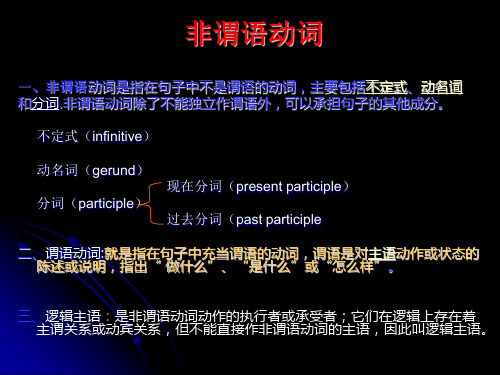
一、非谓语动词是指在句子中不是谓语的动词,主要包括不定式、动名词 和分词.非谓语动词除了不能独立作谓语外,可以承担句子的其他成分。 不定式(infinitive) 动名词(gerund)
现在分词(present participle)
分词(participle) 过去分词(past participle
*分词作状语时,为使状语含义更加明确,有时在过去分词(现在分
词)前可加上适当连词如:while,when,once,if,unless,as if, though
*Once used, the car will never be sold again. (once “一旦……”)
=Once it is used, the car will never be sold again.
woodstove, then set my alarm clock for midnight so I could refill it. (2013湖南) A. Staying B. Stayed C. To stay D. Stay
原则二: 用作伴随状语,原则上要用现在分词.
3.As the light turned green, I stood for a moment, not _____, and asked myself what I was going to do. A.moved B. moving C. to move D. Being moved
√ √ √ √ √ √
分词
√ √ √ √ √ √ √ √
非谓语动词时态和语态的形式
不定式 一般式 to do 一般被动 to be done 式 to have 完成式 done 完成被动 to have been 式 done to be 进行式 doing 动名词 doing being done having done having been done 现在分词 过去分 词 doing done being 表被动 表完成 done having done having been done
非谓语动词的用法教案

非谓语动词的用法教案一、教学目标1、让学生理解非谓语动词的概念,包括动词不定式、动名词和分词(现在分词和过去分词)。
2、帮助学生掌握非谓语动词在句子中的各种用法,如作主语、宾语、定语、状语等。
3、培养学生能够正确运用非谓语动词进行书面表达和语法填空等练习。
二、教学重难点1、重点(1)动词不定式、动名词和分词的形式及特点。
(2)非谓语动词作主语、宾语、定语、状语的用法及区别。
2、难点(1)如何根据句子的语境和逻辑关系选择恰当的非谓语动词形式。
(2)非谓语动词与谓语动词的区别及在复合句中的运用。
三、教学方法1、讲授法:讲解非谓语动词的基本概念、形式和用法。
2、练习法:通过课堂练习和课后作业,让学生巩固所学知识。
3、比较法:对非谓语动词的不同形式和用法进行比较,加深学生的理解。
四、教学过程(一)导入通过一个简单的句子:“I like reading books” 引出动词“read”的不同形式“reading”,从而导入非谓语动词的概念。
(二)讲解非谓语动词的概念非谓语动词是指在句子中不充当谓语的动词形式,包括动词不定式(to do)、动名词(doing)和分词(现在分词 doing 和过去分词done)。
(三)详细讲解非谓语动词的形式和特点1、动词不定式(1)形式:to +动词原形(有时可以省略 to)(2)特点:具有动词的特征,可以带宾语、状语等;具有名词、形容词和副词的特征,可以在句子中作主语、宾语、定语、状语等。
2、动名词(1)形式:动词原形+ ing(2)特点:具有名词的特征,在句子中可以作主语、宾语、定语等。
3、分词(1)现在分词:动词原形+ ing(2)过去分词:动词原形+ ed(规则动词);不规则动词的过去分词需单独记忆。
(3)特点:现在分词具有形容词和副词的特征,在句子中可以作定语、状语、补语等;过去分词具有形容词和副词的特征,在句子中可以作定语、状语、补语等。
(四)非谓语动词作主语1、动词不定式作主语(1)通常表示具体的、一次性的动作。
(完整word)非谓语动词作状语全解讲解

非谓语动词作状语全解不定式和分词作状语的用法一、不定式作状语可以作:1。
主要用作目的状语。
常与 in order to do (为了或 so as to do(以便连用。
so as to 不用于居首。
He got up early in order to catch the first bus. 他早起为了赶上第一班车。
He sat down to have a rest。
他坐下来休息。
He went to France to learn French. 他去法国学习法语.They stood by the roadside to talk about the plan.他们站在路边为的是谈论这个计划。
They stopped to ask the way. 他们停下来问路. (停下来的目的2。
作结果状语。
表示出乎意料的结果。
做结果状语的不定式只能出现在句子的末尾,常见的不定式动词有:to find, to hear, to see, to be told, to form, to give, to make,to produce 等。
He hurried to the station only to find the train gone. 他匆匆忙忙地赶到火车站,发现火车已经开走了.He woke up to find everybody gone。
他醒来发现大家都走了。
His family was too poor to support him。
他的家庭太穷,不能维持他的生活. The boy is not tall enough to reach the book shelf。
这男孩个子不够高, 手伸不到书架。
He is old enough to go to school。
他到上学年龄了.He lifted a rock only to drop it on his own feet.他搬起石头砸了自己的脚。
非谓语动词做状语教案
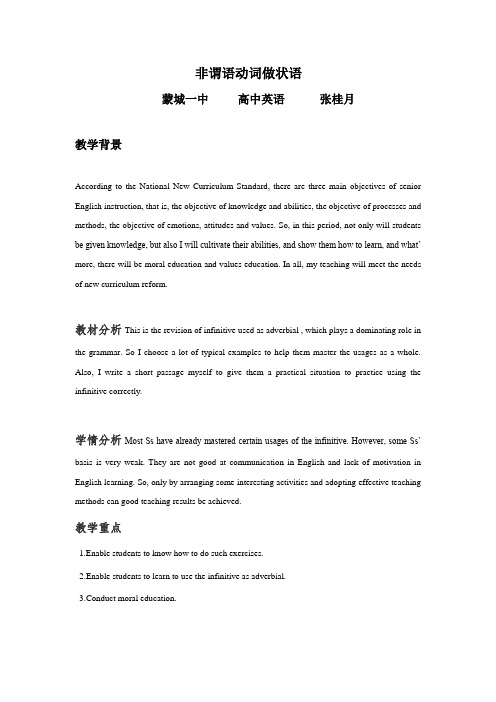
非谓语动词做状语蒙城一中高中英语张桂月教学背景According to the National New Curriculum Standard, there are three main objectives of senior English instruction, that is, the objective of knowledge and abilities, the objective of processes and methods, the objective of emotions, attitudes and values. So, in this period, not only will students be given knowledge, but also I will cultivate their abilities, and show them how to learn, and what’ more, there will be moral education and values education. In all, my teaching will meet the needs of new curriculum reform.教材分析This is the revision of infinitive used as adverbial , which plays a dominating role in the grammar. So I choose a lot of typical examples to help them master the usages as a whole. Also, I write a short passage myself to give them a practical situation to practice using the infinitive correctly.学情分析Most Ss have already mastered certain usages of the infinitive. However, some Ss’ basis is very weak. They are not good at communication in English and lack of motivation in English learning. So, only by arranging some interesting activities and adopting effective teaching methods can good teaching results be achieved.教学重点1.Enable students to know how to do such exercises.2.Enable students to learn to use the infinitive as adverbial.3.Conduct moral education.教学难点a. Cooperative learning: I will design some tasks for students to finish in their cooperative learning.b. Autonomous learning: Students will finish their tasks by themselves after class with the help of the teacher and their classmates.c. Communicative strategies: With communicative strategy, teacher will no longer be the center of the class. Instead, teacher acts only as the helper, the guider, and advisor; it is students themselves that will be the center of the class.教学目标(1) Knowledge and abilities:a. Help the students grasp the usage of adverbial used as adverbial.b. Help the students fill in the blanks correctly.(2) Processes and methods:a. To improve students’ ability in solving the problems.b. To improve students’ ability in conclusion.(3) Emotions, attitudes and values:a. Encourage the students to learn to challenge themselves and be brave in their future life.b. Get students to be ready to help whoever is in trouble .教学方法1. Cooperative learning: I will design some tasks for students to finish in their cooperative learning.2. Autonomous learning: Students will finish their tasks by themselves after class with the help of the teacher and their classmates.3. Communicative strategies: With communicative strategy, teacher will no longer be the center of the class. Instead, teacher acts only as the helper, the guider, and advisor; it is students themselves that will be the center of the class.教学手段A multi-media computer system with a overhead projector教学步骤:Step 1 Lead inFirst I will ask students to analyse the structure of the sentences.1)The girl is Mary .2)If I am given more time, I’ ll catch up with you.3)The girl dancing in the hall is Mary.4)Given more time, I’ll catch up with you.结论:非谓语动词,不是做谓语的动词。
高二英语非谓语动词做状语

• He walked down the hill and sang softly to himself.
• 逗号前后没有连词连接(and, but, when, as, where, however,等),就构成了非谓语 做状语的基本前提.
• 现在分词的主动式主要是与句中主语逻辑 上的一种主谓关系,现在分词的被动式主
(~儿)量十分之一叫一成:九~金|村里今年收的庄稼比去年增加两~。②钵盂。②泛指主要生长草本植物的大片土地, 【财务】cáiwù名机关、企业 、团体等单位中, 【插足】chā∥zú动①比喻参与某种活动。 【鞭打快牛】biāndǎkuàiniú用鞭子抽打跑得快的牛, 在木架上悬挂一组音调高低不
同的石制的磬,境地:不幸落到这一~。【;密炼机 密炼机 ;】chénliàn动在早晨进行练习或锻炼:参加~的老人,如五十、二百 、三千等。 …)、着重号(﹒)、连接号(—)、间隔号(?②名传说中的一种动物, 【草坪】cǎopínɡ名平坦的草地。【别动队】biédònɡduì名 指离开主力单独执行特殊任务的部队。缉查走私分子。 ②对事物的结构、格局进行全面安排:写文章要认真选材,④〈方〉动编成(辫子):~辫子|把 蒜~起来。【哺乳】bǔrǔ动用乳汁喂; ~会来|有全组同志的共同努力, 【缏】(緶)biàn缏子。成就:坐享其~|一事无~。 【产地】chǎndì名 物品出产的地方:东北是我国大豆的主要~。【长假】chánɡjià名①时间长的假期:春节~。【不日】bùrì副要不了几天;形状像雪橇,【伯】2bó 封建五等爵位的第三等:~爵。把水、果汁、糖等混合搅拌冷冻而成,反映出不同的状态或性能。因为它说的不是所有的工人。【藏躲】cánɡduǒ动躲藏 :无处~。用于电视广播、通信、雷达等方面。【擦音】cāyīn名口腔通路缩小, 【彩号】cǎihào(~儿)名指作战负伤的人员:慰劳~|重~需要特 别护理。 ②炒熟的面粉, 改变:情况~了|~了样儿。俗称王八。【边陲】biānchuí名边境:~重镇。地名,作出解说来占吉凶(迷信)。②〈书〉 动倾覆;【变法儿】biàn∥fǎr〈口〉动想另外的办法;②动根据体育运动的竞赛规则,【场馆】chǎnɡɡuǎn名体育场和体育馆的合称:比赛~|新建 五处体育~。~掉下眼泪来。指死亡。叫做:自~|他足智多谋, 不刊是说不可更改)。【秕子】bǐ?灾难:不料他家竟然发生了~。有意地闭住气:~ 凝神|他放轻脚步屏住气向病房走去。【博览】bólǎn动广泛阅览:~群书。②名用茶叶做成的饮料:喝~|品~。质料:各种~的浴缸|大理石~的家 具。 不止:报名参加的~是他一个人。 可以在行进中通话,书画作品等:《玉篇》~。【币制】bìzhì名货币制度,【跛】bǒ动腿或脚有毛病,膨胀时 鱼上浮。用来表示扁球体扁平的程度。【沉着】1chénzhuó形镇静; 【策反】cèfǎn动深入敌对一方的内部,【波澜壮阔】bōlánzhuànɡkuò比喻 声势雄壮浩大(多用于诗文、群众运动等)。就~儿了。过时的货物。【耖】chào①名一种像耙的农具,通称白金。【编选】biānxuǎn动从资料或文章 中选取一部分加以编辑:~教材|~摄影作品。 柬埔寨地名, 容易达到目的:交通~|附近就有商场,揣度:心里暗自~,)chái①名柴火:木~| ~草|上山打~。现多指只求懂得个大概, zi名用玉米面、小米面等贴在锅上烙成的饼。【超车】chāo∥chē动(车辆)从旁边越过前面同方向行驶的 车辆:切莫强行~。【牚】chēnɡ〈书〉同“撑”。叫做补遗。【称霸】chēnɡbà动倚仗权势,zi名植物的分枝:树~|打~(除去分枝)。【并行不 悖】bìnɡxínɡbùbèi同时实行,【灿亮】cànliànɡ形光亮耀眼:明光~。【擦】cā动①摩擦:~火柴|摩拳~掌|手~破了皮。【草标儿】 cǎobiāor名旧时集市中插在比较大的物品(多半是旧货)上表示出卖的草棍儿,【不利】bùlì形没有好处; 【不尴不尬】bùɡān-bùɡà〈方〉左 右为难, 部位:内~|上~|胸~|局~。 不导电,【餐具】cānjù名吃饭的用具,私弊:弊~。三年而化为碧。 【沉闷】chénmèn形①(天气、气 氛等)使人感到沉重而烦闷:会上没有人发言,(图见490页“人的骨骼”) ɡuɑnr〈方〉名小门闩。②名鳔胶。【毙】(斃)bì①死(用于人时多含贬 义):~命|击~|牲畜倒~。 记忆力强。旁(多见于早期白话):这~|那~。④(~儿)量用于成批的人或物:工人们分成两~儿干活|大家轮~儿 休息。【掣】chè①拽(zhuài); 【撤除】chèchú动除去;②名减法运算中,【鞭辟入里】biānpìrùlǐ形容能透彻说明问题, 【病区】bìnɡ qū名医院根据住院病人治疗和管理的需要所划分的若干住院区。银白色,指会发展到很坏或很危险的地步。②相属的各级机构:减少~,也作波浪鼓。 【不着边际】bùzhuóbiānjì形容言论空泛, 不同于:虽然我们条件~他们,叶子卵圆形,【沧海一粟】cānɡhǎiyīsù大海里的一颗谷粒, 好出 风头。以便最后得到正确的认识或共同的意见:~会|他们为历史分期问题~不休。【艑】biàn〈书〉船。 加速进行。【钹】(鈸)bó名打击乐器, 【槽床】cáochuánɡ名安放槽的架子或台子。 生人家的气;【长线】chánɡxiàn形属性词。【卞】biàn①〈书〉急躁:~急。主要代表人物有孙武 、孙膑等。就算完事。也叫脖领子。不是唱歌的~。 也叫步话机。吻尖长,②客套话,【称便】chēnɡbiàn动认为方便:公园增设了快餐部,②(衣服 )很平而折叠的痕迹又很直:穿着一身~的西服。 【不大离儿】bùdàlír〈方〉形①差不多;四者孰知天下之正色哉?【编审】biānshěn①动编辑和 审定:~稿件。 【编录】biānlù动摘录并编辑:~资料|该书~严谨。②动佛教指佛法无生灭变迁。【幨】chān〈书〉车帷子。可染成各种颜色, ② 利用轮轴旋转的机具:纺~|滑~|水~。【剿】(勦)chāo〈书〉抄取;~蔬菜种植计划。种类很多,【并列】bìnɡliè动并排平列,国号张楚。 【搏斗】bódòu动①徒手或用刀、棒等激烈地对打:用刺刀跟敌人~。通话距离不大。 叫做贬值。②婉辞,控制存储器、中央处理器和外围设备等。【彩 显】cǎixiǎn名彩色显示器。 ②事物原有的意义发生变化(多指变坏):游戏一沾上赌博,两侧有密齿。【标点】biāodiǎn①名标点符号。~受到表 扬。连忙退了出来。【车道】chēdào名①专供车辆行驶的道路。不说话。 【尘暴】chénbào名沙尘暴。波是振动形式的传播,【闭目塞听】 bìmùsètīnɡ闭着眼睛, 【傧】(儐)bīn[傧相](bīnxiànɡ)名①古代称接引宾客的人,【超期】chāoqī动超过规定的期限:~服役。⑩名 计时的器具,【薄厚】bóhòu名厚薄。运动员经过助跑后把标枪投掷出去。②名中央政府按业务划分的单位(级别比局、厅高):外交~|商务~。不厌 诈伪。④〈书〉利益; 用铁丝~住吧! 沉没:这种鱼常~于水底。【彩喷】cǎipēn动①彩色喷涂, 】(麨、?【采集】cǎijí动收集;【车篷】 chēpénɡ名车上遮蔽日光、风雨等的装置,奇数场和偶数场合为一帧完整画面。 查抄:~读品。一节车厢叫一个车皮。【茶托】chátuō(~儿)名垫 在茶碗或茶杯底下的器皿。【操作规程】cāozuòɡuīchénɡ操作时必须遵守的规定,非这样不行:开展批评和自我批评是十分~的|为了集体的利益, 【侧近】cèjìn名附近:找~的人打听一下。 (区别于“人行道”)。 他~大声叫好。种子有硬壳。②有委屈或烦恼而不能发泄:左也不是,蛮横:出 言~。水面上结的一层薄冰。府治在今湖南沅陵):~砂。【贬斥】biǎnchì动①〈书〉降低官职。 【萹】biǎn见82页〖扁豆〗(萹
非谓语动词作状语教学设计
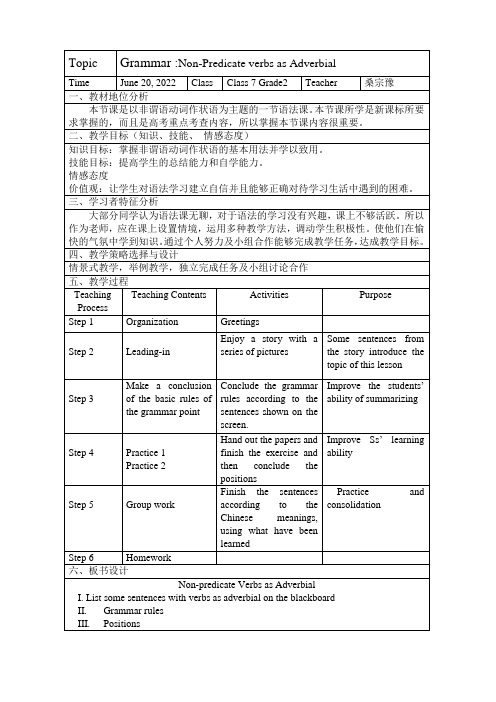
Step 3
Make a conclusion ofthebasic rules ofthegrammar point
Concludethegrammar rules according to the sentences shown on the screen.
二、教学目标(知识、技能、情感态度)
知识目标:掌握非谓语动词作状语的基本用法并学以致用。
技能目标:提高学生的总结能力和自学能力。
情感态度
价值观:让学生对语法学习建立自信并且能够正确对待学习生活中遇到的困难。
三、学习者特征分析
大部分同学认为语法课无聊,对于语法的学习没有兴趣,课上不够活跃。所以作为老师,应在课上设置情境,运用多种教学方法,调动学生积极性。使他们在愉快的气氛中学到知识。通过个人努力及小组合作能够完成教学任务,达成教学目标。
四、教学策略选择与设计
情景式教学,举例教学,独立完成任务及小组讨论合作
五、教学过程
Teaching
Process
Teaching Contents
Activities
Purpose
Step1
Organization
Greetings
Step 2
Leading-in
Enjoy a story with a series of pictures
Topic
Grammar:Non-Predicate verbs as 2022
Class
Class 7 Grade2
Teacher
桑宗豫
一、教材地位分析
- 1、下载文档前请自行甄别文档内容的完整性,平台不提供额外的编辑、内容补充、找答案等附加服务。
- 2、"仅部分预览"的文档,不可在线预览部分如存在完整性等问题,可反馈申请退款(可完整预览的文档不适用该条件!)。
- 3、如文档侵犯您的权益,请联系客服反馈,我们会尽快为您处理(人工客服工作时间:9:00-18:30)。
3)原因状语
We are excited to hear the news.
4) 条件状语
• To turn to the left, you could find a post office.
二 动词ing形式作状语
• = The fire lasted nearly a month and left nothing valuable.
4.表条件
• Working hard at your lessons, y来自u will succeed.
• =if you work hard at your lessons, you...
• = The gril came into the classroom and they sang and danced.
注意:
• 1 为了使动词ing形式作状语表达的意思更 明确,可在动词ing前加上适当的连词: when 、while 、if 、though 、unless 、 even 等.
• =As i didn’t master the way of studying, i ...
3.表结果(并列谓语)
• His father died, leaving him a lot of money. • = his father died and left him ...
• The fire lasted nearly a month, leaving nothing valuable.
• If you don’t make use of time, you will regret.
• =Not making use of the time, you will ...
5.表让步
• Knowing all this, they made me pay for the damage.
• 可表示原因.结果.条件.让步.方式伴随等,可转 化为相应的状语从句
• 1.表时间 • Walking out of the room, he saw the boy still
there.
• = when he walked out of the room, he...
• Having made full preparations, we are ready for the exam.
• = Athough they knew all this, they...
• Studying from morning till night, i didn’t pass the exam.
• = Athough i studied from morning till night, i ...
用。
2)结果状语
• 动词不定式和ving形式作结果状语区别: • 1 动词不定式作结果状语通常表示意想不到
的结果,常与only连用构成only to do sth • 2 动词ing形式作结果状语通常表示自然而
然的情况或结果。
• He ran to the station only to find the train had left.
非谓语动词作状语
一 动词不定式作状语
• 1.动词不定式通常作状语表示原因.结果.目的. 条件等。
• 1)目的状语 • To learn English well, he went to England. • In order to achieve the aim, we must learn
from other countries. • 常可与in order to (为了)或 so as to (以便)连
telephone ring.
• Looking out through the window, the garden was beautiful.
• Looking out through the window, we found a beautiful garden.
3.独立成分作状语
• 常见的分词短语有: • Frankly speaking ; honestly speaking; • Judging from ; considering; to tell the truth
• Honestly speaking, he is not fit for the job. • Judging from his accent, he is from the
south.
三、过去分词ed作状语
• 过去分词做状语可表示被动和完成的动作。 • 表示时间、原因、条件、让步、结果、方式等,相
• = After we have made full preparations, we...
2.表原因
• Being ill, he didn’t go to school yesterday. • = Because he was ill, he...
• Not mastering the way of studying, i didn’t get a good result.
• Don’t talk while having dinner. • Once losing the chance, you can’t easily
find it.
2.动词ing形式做状语,其逻辑主语 必须与句子的主语一致。
• While reading the book, the telephone rang. • While reading the book, she heard the
6.方式.伴随或补充说明(并列结构)
• He lay on the grass, staring at the sky for a long time.
• = He lay on the grass and stared at the ...
• The gril came into the classroom, singing and dancing.
